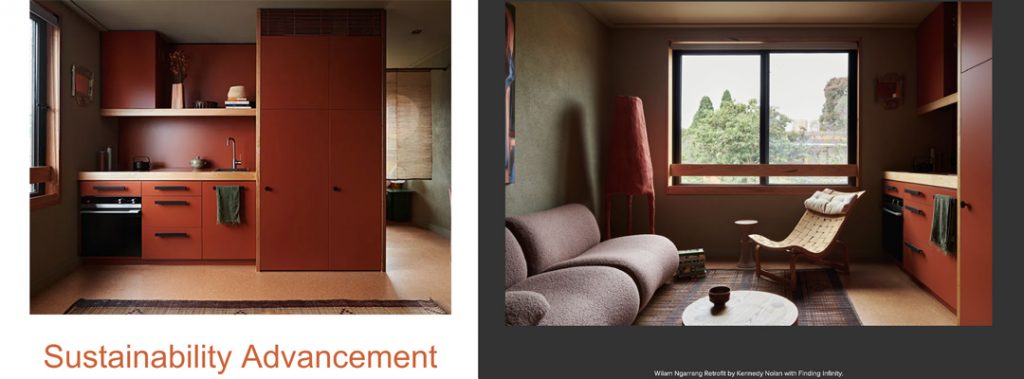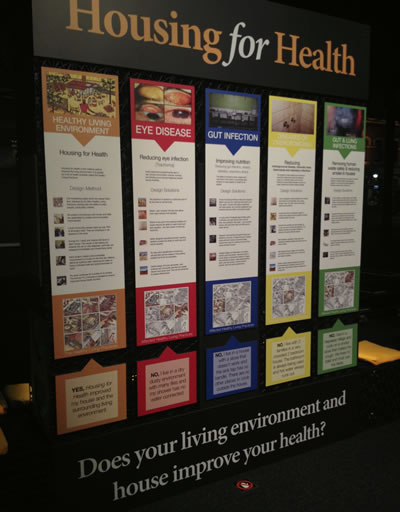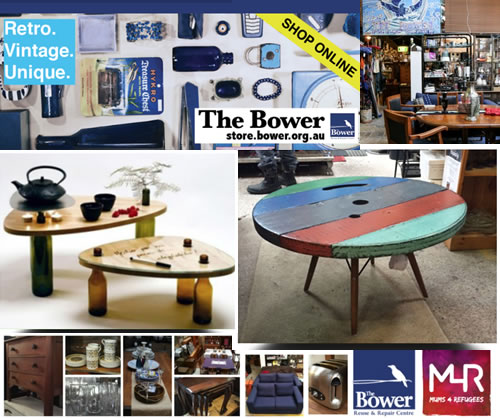Wilam Ngarrang Retrofit by Kennedy Nolan with Finding Infinity Australian Interior Design Awards: Sustainability Advancement
AWARD | ArchitectureAU Editorial 14 Jun 2024. A good example of the designers setting an example by making adaptive re-use & regeneration the primary consideration, while creating welcoming and comfortable human-scale living spaces. architectureau.com/articles/2024-australian-interior-design-awards-sustainability-advancement/#
helps to add many values to interiors. Certification systems for environmentally preferable products are mostly beneficial and genuinely helpful but be wary, as some are self serving. Here’s a global green tag description to start off with and aim to always do some independent research of your own. globalgreentag.com/knowledge.html
Material selection thinking deserves good consideration in all design fields as materials make a significant impact on indoor health quality and for reducing environmental impact or greenhouse gas emissions by choosing eco preferable products. EcoSpecifier created a database set up to help architects, designers, builders and specifiers shortcut the materials sourcing process. (Original Ecospecifier was a joint initiative of the Centre for Design at RMIT, EcoRecycle Victoria and Society for Responsible Design. It’s now part of GlobalGreenTag) globalgreentag.com/read/1095/farewell-ecospecifier.html
- Use all materials sparingly, particularly non-renewable resources Old growth timbers, metals and precious stone are finite resources, for which better alternatives exist.
- Select materials from renewable or recycled sources Recycled materials are now more available, as are renewable materials like straw based particle boards.
- Consider the offgassing properties of some materials Formaldehydes in boards/textiles, benzene and toluene in paints can increase indoor air pollution.
- Use products & furnishings which have considered their life cycle impact Look at office chairs and similar that can be disassembled for recycling to keep them out of landfill.
- Strive for a ‘look’ which is not just a fashion statement Appropriate design will ensure that materials and products will have long years of use.
- Use energy efficient appliances and fittings to save energy and reduce environmental footprint Compact fluoros and halogen lights use minimal energy while curtains and draft stoppers retain heat
- Use materials which will aid in passive solar design Floor tiles and concrete slabs, for example, in sunny winter rooms absorb and reradiate heat at night.
- Use natural ventilation Spaces can be cooled down in summer and rooms ventilated against indoor air pollution
- Make sure specifications address all the eco qualities you are want for your design e.g. specifying timbers certified by the Forest Stewardship Council
- Design an eco deconstruction spec. when renovating or relocating so that materials are not wasted Often no-one knows what to do with site materials, such a spec. means they taken offsite responsibly
- Start a library of eco-products and materials in your office library for others to use as well Clients are often inspired after handling samples of eco-products. Help educate peers by example
- Keep yourselves up to date on eco-design issues Use SRD Ideas and other eco resource lists and certification schemes to keep up with latest issues
- Select products and materials which create a healthy indoor environment Avoid wall to wall carpets by using hard surfaces with floor rugs which can be easily cleaned and aired
- Select water efficient products to save this precious commodity Specify low flow or automatic cut-off taps and fittings, insulated tanks and pipes, quick boil urns, etc.
- Promote the benefits of energy and water conservation to clients While upfront costs may be higher, longer term use actually saves clients big money
- Consider increasing the amount of natural light into spaces to reduce need for artificial lighting In usage and correct placement of windows, internal partitions and colours of walls/surfaces improve lighting
- Specify timbers which they have ensured come from long term renewable sources Timbers recognised by the Forestry Stewardship Council (FSC) and others that are certified as sustainably harvested
- Select ‘pure blend’ textiles, which are most suitable for the job they have to perform 100% blends make for ease of recycling, better still select a material which has already been recycled
- Select fabrics which have come from a more sustainable source For example, DesignTex have a line made from organic ramie/wool dyed with non toxic dyes
- Avoid the use of chemically treated fabrics Moth and stain proofing treatments can impact on both environmental and personal health
- Consider installation of energy saving devices Such as movement and light sensors for artificial lighting in offices and home to reduce energy use
- Specify low Volatile Organic Compound emission paints Plant or mineral based products emit less VOCs, which can contribute to Sick Building Syndrome
- Use materials for presentation boards which can either be used again or recycled Avoid styrene boards which can be difficult to recycle and conserve samples for further reuse
- Prepare working drawings on A4 & A3 paper or digital files on disks for easy copying Consultants or contractors don’t need all the details on an large wasteful sheets








